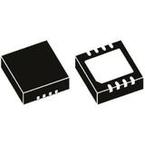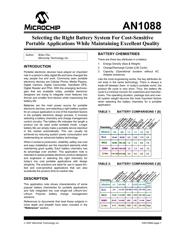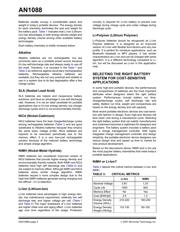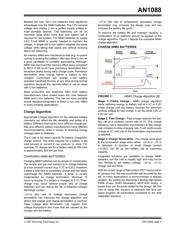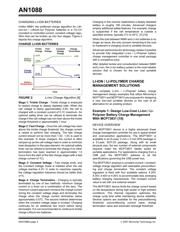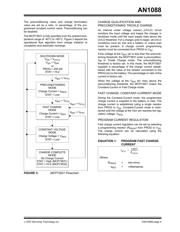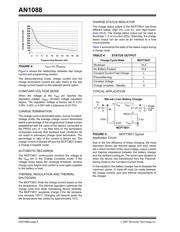herunterladen

© 2007 Microchip Technology Inc. DS01088A-page 1
AN1088
INTRODUCTION
Portable electronic devices have played an important
role in a person’s daily digital life and have changed the
way people live and work. Commonly seen portable
electronic devices are Cellular Phone, Media Players,
Digital Camera, Digital Camcorder, Handheld GPS,
Digital Reader and PDA. With the emerging technolo-
gies that are available today, portable electronic
designers are trying to integrate more features into
thinner and smaller form-factors while maximizing the
battery life.
Batteries are the main power source for portable
electronic devices, and selecting a right battery system
for an unique application is one of the important factors
in the portable electronic design process. It involves
selecting a battery chemistry and charge management
control circuitry. The battery life indicates the length a
product can be used under portable mode. Longer
battery life can simply make a portable device standout
in the market automatically. This can usually be
achieved by reducing system power consumption and
implementing an advanced battery technology.
When it comes to production, reliability, safety, low-cost
and easy installation are the important elements while
maintaining good quality. Each battery chemistry has
its advantage over another. This application note is
intended to assist portable electronic product designers
and engineers in selecting the right chemistry for
today’s low cost portable applications with design
simplicity. The solutions are ideal for use in space-lim-
ited and cost-sensitive applications that can also
accelerate the product time-to-market rate.
DESCRIPTION
This application note shows characteristics of some
popular battery chemistries for portable applications
and fully integrated low cost single-cell Lithium-Ion/
Lithium Polymer battery charge management
solutions.
References to documents that treat these subjects in
more depth and breadth have been included in the
“Reference” section.
BATTERY CHEMISTRIES
There are three key attributes in a battery:
1. Energy Density (Size & Weight)
2. Charge/Discharge Cycles (Life Cycle)
3. Capacity (Operational duration without AC
Adapter presence)
Like the most engineering works, the key attributes do
not exist in the same technology. There is always a
trade-off between them. In today’s portable world, the
product life cycle is very short. Thus, the battery life
cycle is a minimal concern for customers and manufac-
turers. The operating duration, package size and over-
all system weight become the most important factors
when selecting the battery chemistry for a portable
application.
TABLE 1: BATTERY COMPARISONS 1 [8]
TABLE 2: BATTERY COMPARISONS 2 [8]
Author: Brian Chu
Microchip Technology Inc.
Chemistry
Energy Density
Weight (W
-
hr/K
g
)
En
er
g
y
De
nsi
ty
Vo
lu
me
(W
-
hr/L)
Ope
r
ati
n
g
V
oltag
e
(V)
Open
C
i
rc
u
it
V
oltag
e
(V)
E
n
d
Vol
tage
(
V)
C
h
ar
g
e
Voltage (V)
SLA
30-40
50-80
2.0 2.25 1.75 2.8
NiCd
40-80 100-150 1.2 1.3 0.9 1.6
NiMH
60-100 160-230 1.2 1.3 0.9 1.5
Li-Ion
110-130 210-320 3.6 4.2 2.8 4.2
Alkaline
145 400 1.2 1.6 0.9 NA
Chemistry
Energy Density
Weight (W
-
hr/K
g
)
En
er
g
y
De
nsi
ty
Vo
lu
me
(W
-
hr/L)
Ope
r
ati
n
g
V
oltag
e
(V)
Open
C
i
rc
u
it
V
oltag
e
(V)
E
n
d
Vol
tage
(
V)
C
h
ar
g
e
Voltage (V)
SLA
30-40
50-80
2.0 2.25 1.75 2.8
SLA
30-40
50-80
2.0 2.25 1.75 2.8
NiCd
40-80 100-150 1.2 1.3 0.9 1.6
NiCd
40-80 100-150 1.2 1.3 0.9 1.6
NiMH
60-100 160-230 1.2 1.3 0.9 1.5
NiMH
60-100 160-230 1.2 1.3 0.9 1.5
Li-Ion
110-130 210-320 3.6 4.2 2.8 4.2
Li-Ion
110-130 210-320 3.6 4.2 2.8 4.2
Alkaline
145 400 1.2 1.6 0.9 NA
Alkaline
145 400 1.2 1.6 0.9 NA
Alkaline
SLA
NiCd
NiMH
Li-Ion
Chemistry
Se
lf-Disc
h
arge
per Month (%)
Internal
R
e
s
ist
a
n
c
e
(
m
Ω)
D
is
c
ha
r
ge
R
at
e
(
mA-
h
r.)
Operating
T
e
mpe
ra
t
u
re
(
°
C)
I
n
it
i
al C
o
s
t
2-8 2.5-25 50-500 <15C -20-+50 Low
0.3 100-300 1 0.25C -20-+55
Very
Low
15-20 3.5-300 1500 <10C -20-+60 Low
20-25 10-400 800 <3C 0-+60 Med
6-10 50-500 1000 <2C -20-+60 High
C
h
a
rge/Discharge
Cycl
e
s
Alkaline
SLA
NiCd
NiMH
Li-Ion
Chemistry
Se
lf-Disc
h
arge
per Month (%)
Internal
R
e
s
ist
a
n
c
e
(
m
Ω)
D
is
c
ha
r
ge
R
at
e
(
mA-
h
r.)
Operating
T
e
mpe
ra
t
u
re
(
°
C)
I
n
it
i
al C
o
s
t
2-8 2.5-25 50-500 <15C -20-+50 Low
0.3 100-300 1 0.25C -20-+55
Very
Low
15-20 3.5-300 1500 <10C -20-+60 Low
20-25 10-400 800 <3C 0-+60 Med
6-10 50-500 1000 <2C -20-+60 High
C
h
a
rge/Discharge
Cycl
e
s
Selecting the Right Battery System For Cost-Sensitive
Portable Applications While Maintaining Excellent Quality
Verzeichnis

